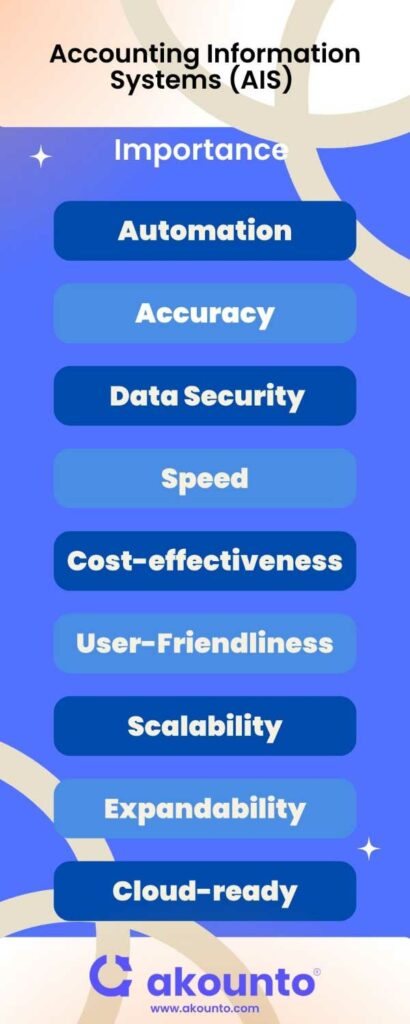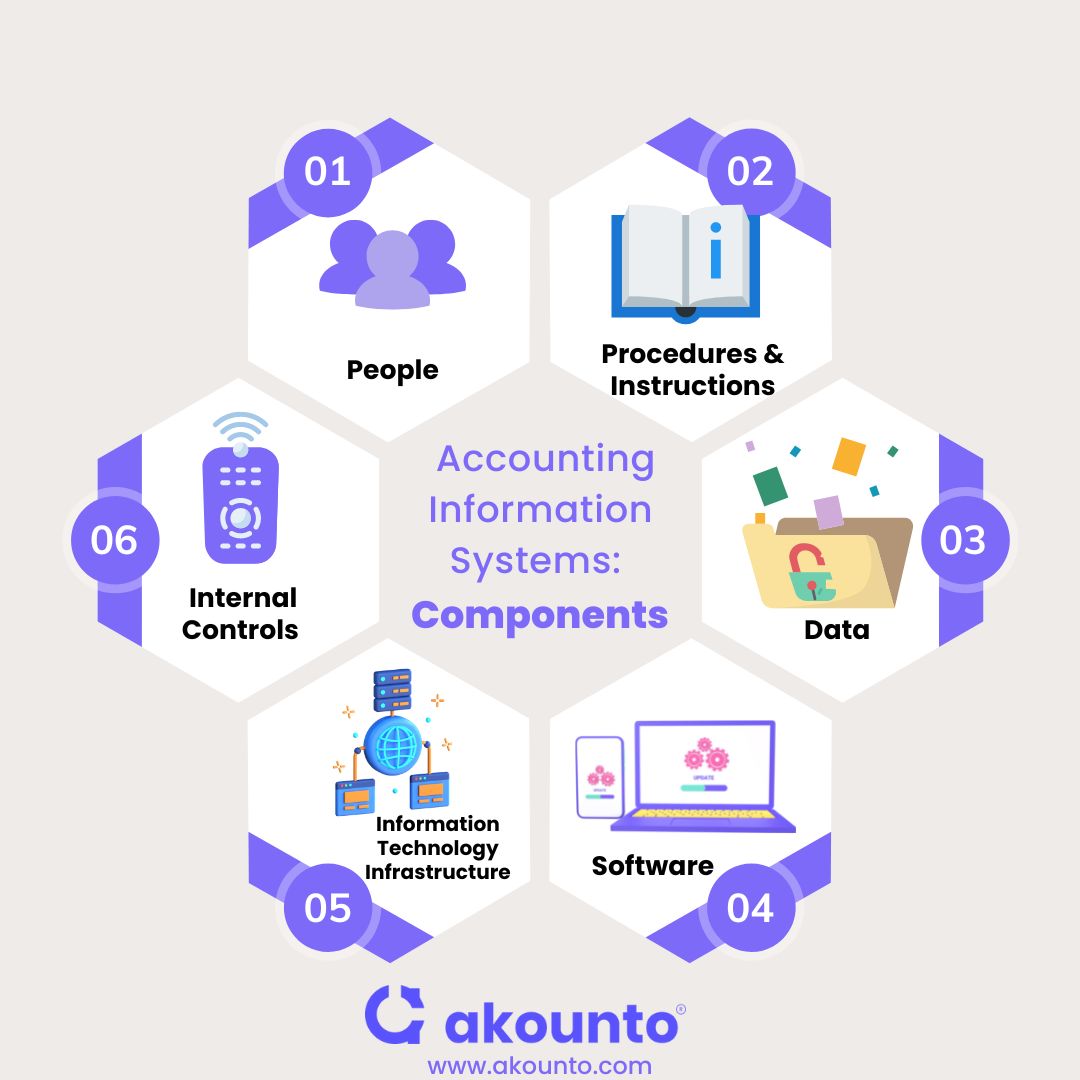What is an Accounting Information System?
An Accounting Information System (AIS) collects, stores, retrieves and structurally processes financial data using sufficient information technology resources.
Companies and businesses have well-structured financial systems for reporting financial transactions and tracking accounting activity. Small businesses may rely on manual and traditional bookkeeping methods, but information technology infrastructure has become an inevitable component of accounting information systems.
Professional accountants use this computer-based method for accurate data entry to make a company’s financial books available to legitimate users. These include the tax authorities, business analysts, external auditors, the chief financial officer, and other interested parties using these reports for financial analysis and audits.
Accounting information systems are seamlessly integrated with major functional areas of a business and are thus enterprise-wide information systems.
AIS aims to provide financial information and reports in real-time and on an “on-demand” basis for internal and external users.
Traditional accounting and bookkeeping aim to record and classify business transactions and generate periodic (quarterly, bi-annually, annual) reports.
AIS provides all the features of traditional bookkeeping and accounting and additionally provides reports on a real-time basis which encompasses a large set of data covering multiple business domains, product lines, etc., to enable decision-making and planning by providing relevant, reliable, “on-demand,” and tailored reports.
AIS supports a wide array of financial reporting domains and integrates company-wide data covering accounting, bookkeeping, auditing, management accounting, taxation, payroll, financial budgeting, etc. The massive collaboration helps to link data and read patterns, trends, and deeper insights, enabling the decision-makers to view the information more qualitatively.
For external users, the AIS follows GAAP or IFRS-based accounting methodologies and principles. For internal users, the AIS data processing can be easily tailored according to management needs or the objective of decision-making.
Importance of Accounting Information Systems

1. Automation
Your financial records keep compiling as you input data into your accounting information system. It eliminates the manual preparation of books and complex computations, which have become inevitable now that businesses have evolved so much.
2. Accuracy
Accounting information is safer, more reliable, and more accurate with information technology resources than with manual bookkeeping and calculations. So, one reason an effective AIS is essential for a business is accurate and reliable financial information.
3. Data Security
Soft copy accounting reports are less susceptible to loss and theft, especially with all the cyber security laws and regulations. Also, accounting information systems AIS come with authorized access, not only for computer programs but also for specific files and identities.
4. Speed
Financial reports assemble according to the fed algorithm in the AIS, and the management does not have to wait for manual preparation of the financial statements. The process stays seamless and efficient as long as the daily transaction entries are made.
5. Cost-effectiveness
A structured accounting system reduces the company’s cost in hiring more workforce for individual tasks or rectifying accounting errors afterward. The accuracy, speed, efficiency, and security of financial data by the AIS make the whole process cost-effective for the company.
6. User-friendliness
Accounting information systems come with easy navigation and a straightforward interface so that the company spends minimum resources on the training of accountants. A user-friendly AIS also streamlines the process as it is also used by customers, investors, creditors, and stakeholders.
7. Scalability
An effective accounting information system is scalable with upgrades and additional storage media. So that whenever a company decides to take a step further, the system also takes a step further along with all the previous accounting data, audit reports, and financial statements.
8. Expandability
Accounting systems with a high-end IT infrastructure should be able to accommodate global expansion, such as multi-lingual and multi-currency features. With manual accounting, international expansion or even national-level scalability would have been a more difficult task.
9. Cloud-ready
Firms and businesses using cloud-based accounting systems receive five times more clients than comparable businesses that are not yet cloud-ready and experience considerably better annual growth as well.
Components of an AIS

1. People
AIS people are the users of the accounting information system. Professionals who may use a company’s AIS include:
- Consultants
- Certified Public Accountant (CPO)
- Auditors, including the government agencies such as IRS
- Chief Financial Officers
- Business Analysts
- Managers
2. Procedures and Instructions
Procedures and instructions of an Accounting Information System (AIS) refer to the methods the system uses for collecting, storing, retrieving, and processing data. For example, the method can be manual or automated, and the source can be internal or external. Currently, most companies use computer-based methods and programs for a streamlined process of recording and processing data, as the American Accounting Association (AAA) recommended.
3. Data
The data in the accounting information system (AIS) includes all the financial information related to a business, and its nature depends upon many factors. This data will include the inventory, customer receipts, and production costs for the sales business. This data will then be used to prepare financial statements for future audits, bank loans, business tracking, and by consulting firms for expert advice.
4. Software
The fourth component of the AIS is the type of AIS software a company uses for financial reporting. Since the advent of computers, software has become an essential component of accounting information, replacing paper-based manual systems. Some large-scale companies prefer to design their software using input from end-users to suit their specific needs.
For public companies, Sarbanes-Oxley Law dictates the format and structure of the Accounting Information system. So, these won’t have much of choice here. The companies must comply with some auditing regulations, internal controls, and public financial statements, and the AIS software ensures that.
5. Information Technology Infrastructure
The hardware used by the accounting information system (AIS) refers to the IT infrastructure. An optimum IT infrastructure should have the following characteristics:
- Speed
- Sufficient storage capacity
- Expandable
- Upgradable
The IT infrastructure includes computers, servers, routers, printers, a backup power supply, and storage media. Companies with integrated financial accounting information systems prefer a hardware and software plan with upgrades, maintenance plans, and IT waste disposal services.
6. Internal Controls
The sixth element of an AIS is the internal controls, which refer to the security measures and procedures it includes for the authenticity of the financial data. An authentic accounting information system should feature authorized computer and file access for sufficient protection of the financial data.
Computer programs in the AIS must be equipped to safeguard the user data such as the buyer’s information, social security numbers, salary information of the employees, and details of the financial transactions of the firm.
Types of Accounting Information Systems
An information system for recording fiscal data can be classified in various ways, but mainly, there are three types:
- Small and medium-sized businesses use manual accounting systems with pretty straightforward finances. Everything is managed manually without any integrated software.
- Legacy systems are the accounting information systems most firms have used since basic technology and software came into accounting. These are hard to abandon by the old companies and organizations because of the historical data these accounting systems have been storing.
- Modern or integrated accounting information systems are high-end, sophisticated accounting information software considered more user-friendly and reliable than legacy systems.
Real-World Examples
A Sales Business AIS
With a well-designed accounting information system, the same system will be used at different steps by different people for automated financial bookkeeping.
To achieve the sales goals the management sets, the staff orders a proportionate amount of inventory. The accounting department receives a new payable for the inventory order, and the rest of the accounting steps can go in the following way:
- Sales staff enters the customer orders
- The customer receives the accounting bills
- The warehouse staff assembles the order
- Order gets marked ‘shipped’ in the system
- The accounting department gets a new receivable
- The accounting department and decision-makers then use the accounting data for financial reporting, cost projections, financial analysis, etc.
The WorldCom Accounting Scandal
WorldCom has to be the largest accounting fraud in American history. In 2002, internal auditors Cynthia Cooper and Eugene Morse used the company’s internal controls and AIS to track fraudulent entries of around $4 billion. The labor cost for the WorldCom capital projects was being allocated as an expense, showing a better growth and profit rate for the company.
This scandal was one of the series of accounting scandals in the early 2000s that led to strictly regulated accounting systems in the form of section 404 of the Sarbanes-Oxley Law.
To know more about accounting and everything around it, you can also visit our blog.




